You’ll discover that Etruscan goldsmiths mastered granulation by creating uniform gold spheres smaller than sand grains, using colloidal soldering with tragacanth gum and copper salts that bonded at 890°C without visible solder marks. They perfected high-karat alloys with precise silver and copper ratios, employed sacred gold acquisition methods from riverbeds, and developed charcoal firing techniques for sphere formation. Their matte finishing innovations and filigree wirework remained lost for centuries until Castellani’s groundbreaking rediscovery efforts sparked the Victorian Etruscan Revival movement that continues influencing modern jewelry craftsmen today.
The Art of Granulation: Creating Perfect Golden Spheres
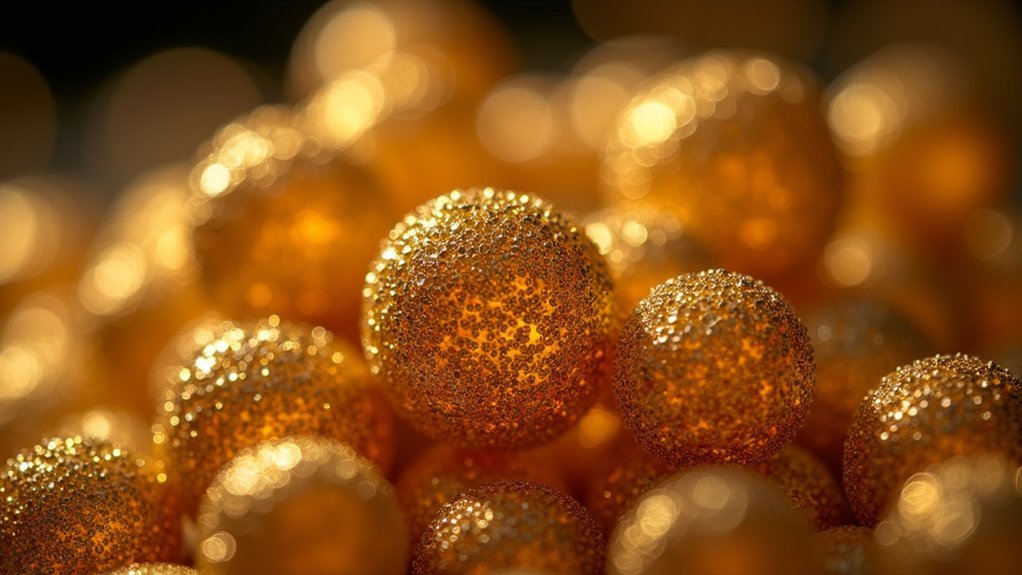
Mastery defined the Etruscan approach to granulation, where artisans transformed molten gold into perfectly uniform spheres no larger than grains of sand.
You’d witness craftsmen rolling precious metal sheets or coiling thin wire with remarkable precision. They’d place these preparations in crucibles with charcoal, firing them until the metal formed tiny, perfect spheres.
This granulation technique required extraordinary skill and patience. You’d see artisans create countless miniature golden orbs, each one destined to become part of intricate decorative patterns.
The spheres needed identical size and shape to achieve the stunning visual effects that made Etruscan jewelry legendary.
These granules would later adorn surfaces with complex designs featuring animals and mythical creatures, demonstrating the unparalleled artistic excellence that distinguished Etruscan goldsmithing throughout the ancient world.
Colloidal Soldering: The Lost Chemical Bonding Method
While traditional soldering relied on high temperatures that could damage delicate granules, Etruscan artisans developed an ingenious chemical bonding method that revolutionized their craft.
Etruscan goldsmiths mastered low-temperature chemical bonding, replacing destructive high-heat soldering with innovative techniques that preserved delicate metalwork.
You’d marvel at their colloidal soldering technique, which combined tragacanth gum and copper salts to create strong bonds at just 890°C. This process eliminated the need for traditional flux or visible solder remnants.
You’d start by painting the metal surface with this colloidal mixture, then carefully arrange your golden granules before firing in a reducing atmosphere.
The copper salt activates during heating, diffusing into both the granules and base metal to create permanent bonds. This advanced technique allowed Etruscan goldsmiths to achieve intricate granulation patterns that you can still see in ancient jewelry like First Century B.C. Indian earrings.
Sacred Gold Sources and Temple Treasures
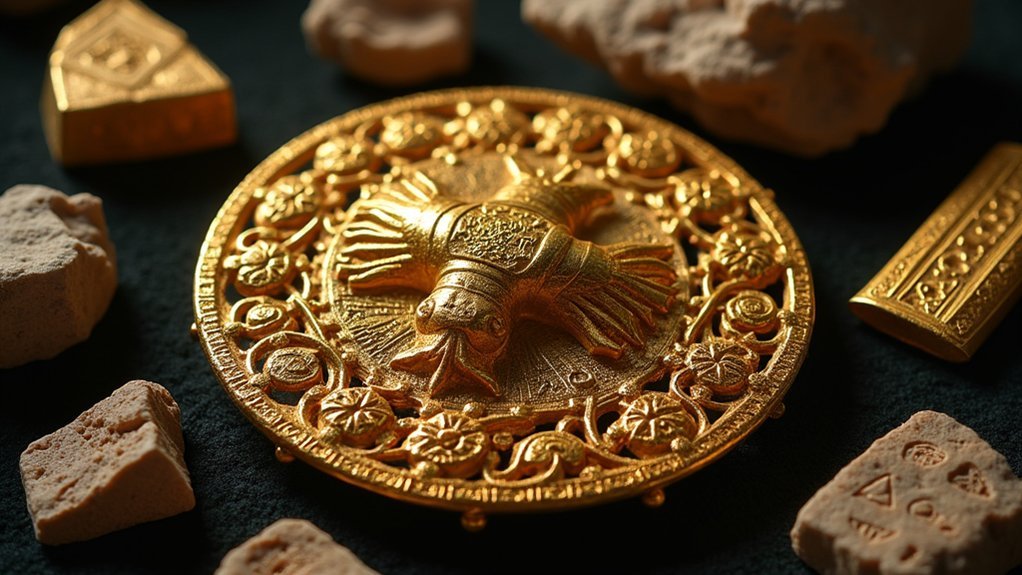
You’ll discover that Etruscan gold wasn’t just randomly collected—they’d developed sacred methods for gathering precious metal from riverbeds, treating each nugget as a divine gift.
Once obtained, you’d find this gold carefully transported to temples where priests stored it using specific ritual practices that honored the gods.
These temple treasuries became massive repositories of wealth, where you’d see gold accumulated not just for economic power, but as tangible proof of divine favor flowing through Etruscan society.
Divine Gold Collection Methods
Three primary methods governed how ancient Etruscans acquired their sacred gold for religious purposes.
You’d find they controlled specific mining territories, much like the Lydian kings who dominated gold resources in their regions. These ancient techniques involved extracting precious metal from riverbeds and mountainous areas considered divinely blessed.
You’ll discover they also obtained gold through tribute systems and taxation, where conquered peoples provided gold as payment to Etruscan rulers. This gold then flowed directly into temple treasuries, reinforcing the connection between political power and religious authority.
Finally, they acquired sacred gold through trade networks, exchanging goods with distant civilizations.
You’d see this precious metal immediately consecrated for religious use, creating the magnificent temple treasures that archaeologists continue uncovering today.
Temple Storage Sacred Practices
Once Etruscan gold reached sacred spaces, temple priests implemented elaborate storage rituals that transformed mere metal into divine treasure. You’d witness these sacred practices where gold wasn’t simply hoarded but ceremonially consecrated through religious rites before temple storage.
The priests followed specific protocols:
- Purification ceremonies – Gold artifacts underwent ritual cleansing to remove earthly impurities.
- Divine blessing rituals – Sacred invocations imbued pieces with godly protection and power.
- Hierarchical placement – Items were positioned according to religious significance and donor status.
You’d find that temple storage served dual purposes in Etruscan society. These repositories didn’t just safeguard wealth—they created liquid assets for ransoms and taxes while demonstrating ruling elite power.
The accumulated treasures reflected both spiritual devotion and political influence, making temples essential centers of economic and religious authority.
Bernardini Tomb: A Masterclass in Etruscan Craftsmanship
Discovery in 1876 revealed one of archaeology’s most spectacular treasures when excavators unearthed the Bernardini Tomb, a burial site that would forever change our understanding of Etruscan goldsmithing mastery.
You’ll find extraordinary examples of Etruscan jewelry showcasing the granulation technique, where artisans meticulously applied tiny gold spheres to create intricate decorative patterns on cloak buckles and ornaments.
The tomb’s artifacts demonstrate how Etruscans combined artistic vision with sophisticated metalworking skills during the Orientalizing period.
You can observe mythological figures and animals crafted with remarkable precision, reflecting the civilization’s wealth and cultural sophistication.
These golden treasures weren’t merely decorative—they symbolized status and power, revealing gold’s central role in Etruscan society’s social hierarchy and religious practices.
The Santerna Mixture: Ancient Soldering Compound Secrets
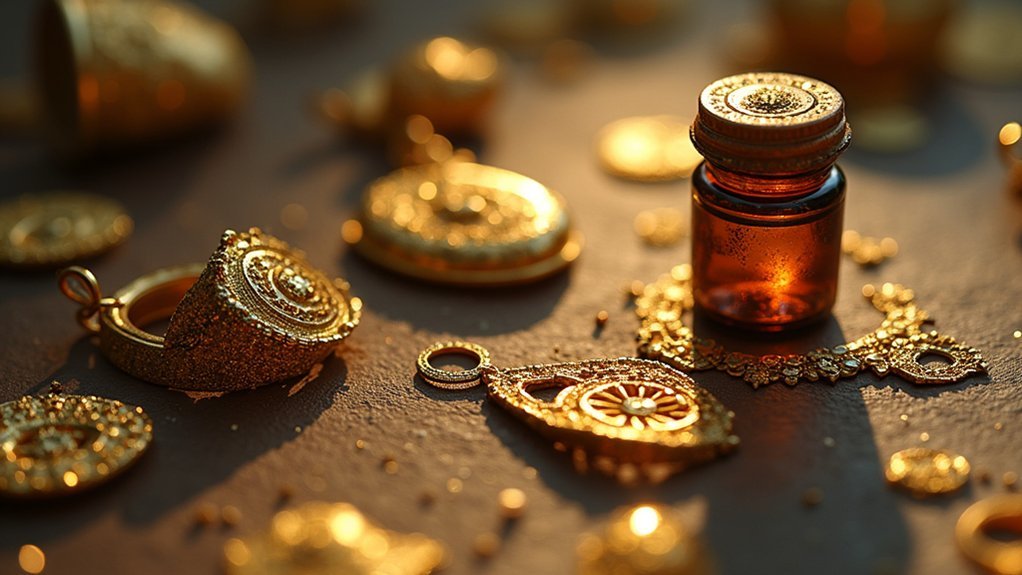
Behind the glittering surfaces of Etruscan treasures lay a remarkable technological innovation that enabled their legendary granulation technique—the santerna mixture.
You’ll find this ancient soldering compound revolutionized goldsmithing by combining metals with exceptionally low melting points, allowing artisans to join delicate gold components without traditional hard solder.
The santerna mixture’s effectiveness depended on three critical factors:
- Precise temperature control during heating to activate the compound properly
- Expert material knowledge to manipulate metallurgical properties effectively
- Skillful application techniques to create strong, lasting bonds between surfaces
You can see how this sophisticated compound enabled Etruscans to attach tiny gold spheres to jewelry surfaces, creating intricate patterns that modern jewelers still admire.
Contemporary research continues revealing secrets of this ancient technology.
Filigree Wirework and Surface Decoration Techniques
While the santerna mixture provided the foundation for joining delicate gold elements, Etruscan artisans elevated their craft through masterful filigree wirework that transformed simple metal threads into breathtaking decorative patterns.
You’ll find their technique involved twisting and curling fine high-karat gold wires into intricate spirals, leaves, and flowers that showcased extraordinary craftsmanship.
When you examine Etruscan jewelry, you’ll notice how they layered these delicate wire designs to create remarkable depth and texture.
The filigree wirework wasn’t merely decorative—it enhanced structural integrity while keeping pieces lightweight and comfortable.
Combined with granulation techniques, this approach produced visually striking jewelry with lustrous finishes.
You’d discover that their exceptional aesthetic sensibility turned functional metalwork into artistic masterpieces that demonstrated sophisticated understanding of both form and function.
High-Karat Gold Alloy Compositions and Metallurgy
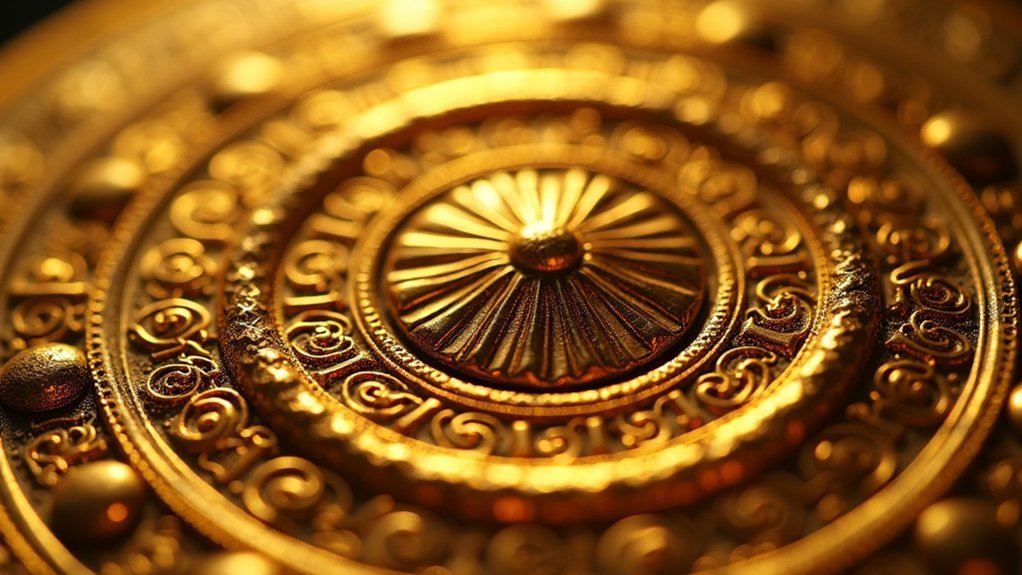
You’ll find that Etruscan goldsmiths consistently worked with 22-karat gold, creating alloys that balanced purity with practical workability.
They’d carefully mix silver and copper into their gold compositions, achieving specific ratios that enhanced both the metal’s rich color and its structural properties.
These ancient metallurgists understood that their precise alloy formulations were essential for executing the intricate granulation and decorative techniques that defined their legendary craftsmanship.
22-Karat Gold Standards
As you examine ancient Etruscan jewelry today, you’re witnessing the mastery of high-karat gold alloys that contained at least 91.6% pure gold.
These karat gold standards represented the pinnacle of ancient metallurgy, setting benchmarks that modern artisans still respect.
Etruscan craftsmen understood that their 22-karat compositions provided ideal workability for sophisticated techniques.
You’ll notice how they strategically incorporated trace elements to enhance their creations:
- Silver additions – Enhanced the natural golden color while maintaining malleability
- Copper traces – Improved durability without compromising the gold’s softness
- Precise ratios – Enabled advanced techniques like colloidal soldering and granulation
You can see how these karat gold standards influenced centuries of jewelry making, from ancient Rome through the Victorian Etruscan Revival movement.
Ancient Alloy Ratios
The specific proportions within these high-karat compositions reveal the sophisticated metallurgical knowledge Etruscan craftsmen possessed. You’ll find their alloys typically contained gold exceeding 22 karats, blended with silver and copper in carefully calculated ratios. These ancient civilizations understood how each metal affected the final product’s characteristics.
| Metal | Percentage | Purpose |
|---|---|---|
| Gold | 85-95% | Primary precious metal, luster |
| Silver | 2-10% | Color modification, workability |
| Copper | 3-8% | Hardness enhancement |
You’d notice regional variations reflecting local gold deposits’ natural compositions. The Etruscans’ mastery allowed them to manipulate these ratios for specific techniques like granulation. Their understanding of alloy behavior under heat enabled colloidal soldering, seamlessly joining granules without compromising the gold’s integrity or diminishing its brilliant appearance.
Charcoal Firing Methods for Sphere Formation
When Etruscan goldsmiths needed to create perfectly formed spheres for their intricate granulation work, they developed sophisticated charcoal firing techniques that maximized heat efficiency while preventing oxidation.
Etruscan artisans mastered charcoal firing methods to produce flawless gold spheres, achieving optimal heat control while eliminating destructive oxidation during metalwork.
You’d find these artisans expertly layering metal fragments with charcoal in crucibles, creating an ideal environment for consistent melting temperatures.
Their charcoal firing methods involved three critical steps:
- Loading the crucible – Metal portions were strategically placed between charcoal layers to guarantee even heating distribution.
- Controlling the firing process – Gold was heated precisely to melting point, forming small decorative spheres while charcoal prevented granules from sticking together.
- Post-firing preparation – Spheres were carefully cooled, cleaned, and sorted by size to assure uniform application in their granulation designs.
This systematic approach revolutionized their goldsmithing capabilities.
Matte Finishing and Surface Treatment Innovations
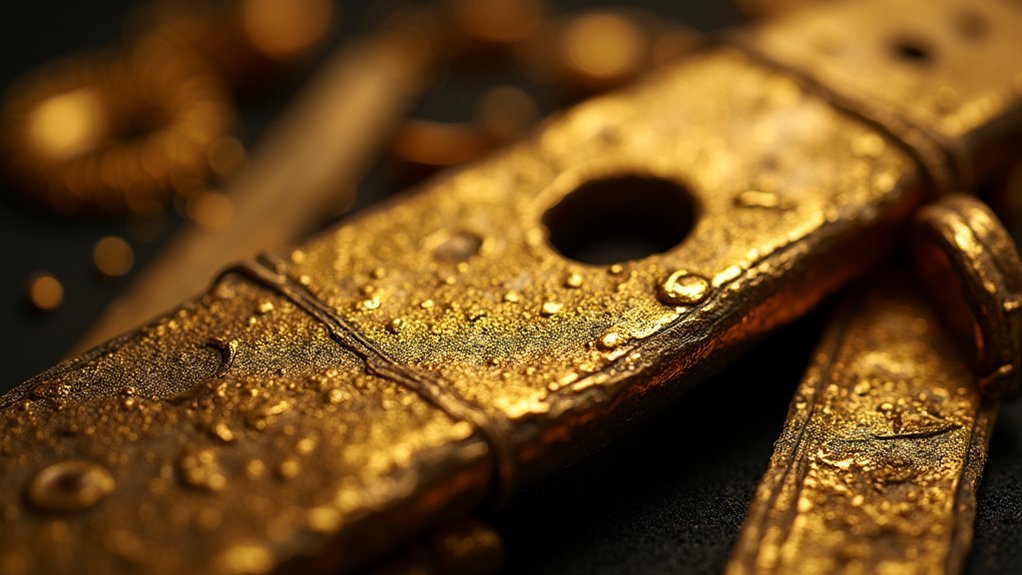
Beyond mastering sphere formation, Etruscan artisans revolutionized gold’s visual appeal through their innovative matte finishing techniques.
You’ll find that blooming, their signature method, involved heating gold to create a soft, brushed sheen that transformed ordinary surfaces into sophisticated works of art. This matte finishing wasn’t merely decorative—it enhanced intricate granulation and filigree patterns, making each detail more pronounced and visually striking.
You’d appreciate how these craftsmen manipulated texture through advanced surface treatments, elevating their jewelry’s luxury and craftsmanship.
They cleverly paired glazed faience ceramics with matte gold finishes, creating stunning material contrasts.
Their innovations weren’t forgotten—Victorian-era jewelers adopted similar techniques, proving that Etruscan matte finishing methods created a lasting legacy that influenced jewelry design for centuries.
Castellani’s Rediscovery of Forgotten Goldsmithing Skills
You’ll find that Castellani’s breakthrough came through systematic investigation of ancient jewelry pieces, particularly after viewing the extensive Campana collection in 1836.
He partnered with skilled craftsmen from Sant’Angelo in Vado, whose traditional techniques proved essential for recreating the complex Etruscan methods.
Through this collaboration, you can see how Castellani mastered the challenging granulation technique that had puzzled goldsmiths for centuries.
Ancient Jewelry Investigation Methods
Although centuries had passed since Etruscan artisans last practiced their intricate goldsmithing techniques, Fortunato Pio Castellani refused to accept that these ancient secrets were lost forever.
You’d find his methodical investigation of Etruscan culture fascinating, as he examined precious metals works of art from the ancient world with scientific precision.
Castellani’s investigation methods included:
- Systematic examination – He meticulously studied over a thousand ancient pieces, including the treasure trove Campana collection.
- Technical analysis – He analyzed the technique called granulation, where small spheres decorated with granulation required specific melting point control using a layer of charcoal.
- Collaborative research – He partnered with skilled artisans who’d later help reproduce these goldsmith techniques.
This century-defining work, building on knowledge from century BC sources like Pliny the Elder, would later influence the early 20th Century revival movement.
Sant’Angelo Craftsmen Partnership
When Castellani realized he couldn’t crack Etruscan goldsmithing secrets alone, he turned to the skilled craftsmen of Sant’Angelo in Vado for help.
You’ll find this partnership became the cornerstone of his revolutionary approach to ancient jewelry reproduction. These local artisans possessed traditional metalworking techniques that had been passed down through generations, making them ideal collaborators for Castellani’s ambitious project.
Working closely with these craftsmen, you’d see Castellani methodically reverse-engineer Etruscan pieces from the Campana collection.
Together, they experimented with granulation techniques, filigree work, and intricate soldering methods that had mystified jewelers for centuries.
This collaboration didn’t just produce beautiful reproductions – it revived lost goldsmithing skills that would’ve otherwise disappeared forever, establishing the foundation for the entire Etruscan Revival movement.
Granulation Technique Mastery
Granulation – the ancient art of decorating gold surfaces with tiny spheres – represents perhaps the most challenging technique Castellani and his Sant’Angelo partners tackled.
When you examine Etruscan jewelry, you’ll notice the extraordinary precision of thousands of minute gold granules perfectly fused without hard solder.
Castellani’s breakthrough came through understanding three vital elements:
- High-karat gold purity – Essential for achieving proper fusion temperatures
- Colloidal soldering technique – Mixing tragacanth gum with copper salts created the bonding agent
- Precise heat control – Avoiding temperatures that would melt the delicate granules
You’re witnessing the rediscovery of techniques lost for centuries.
Castellani’s mastery of this ancient method sparked the Etruscan Revival, proving that dedicated research could reveal civilization’s most guarded goldsmithing secrets.
Frequently Asked Questions
What Is the Etruscan Gold Technique?
You’d recognize Etruscan gold technique by its signature granulation method, where you’ll see tiny gold spheres meticulously applied using colloidal soldering and “santerna” mixture, creating intricate designs that showcase exceptional craftsmanship.
What Is the Etruscan Gold Book?
You’re looking at the world’s oldest surviving book with connected pages – a 23.82-karat gold artifact from 660 BC containing six pages of Etruscan mystical symbols related to death rituals.
What Did Etruscans Use Gold For?
You’d find Etruscans used gold for crafting intricate jewelry through granulation and filigree techniques, creating currency, making religious temple offerings, decorating tombs as grave goods, and producing trade items for Mediterranean commerce.
How to Identify Etruscan Jewelry?
You’ll recognize Etruscan jewelry by examining its intricate granulation with tiny gold spheres, detailed animal motifs, delicate filigree wirework, high-karat gold content, and characteristic matte finish that creates a distinctive brushed sheen.
In Summary
You’ve now uncovered the remarkable goldsmithing techniques that made Etruscan artisans legendary throughout the ancient world. You can see how their mastery of granulation, colloidal soldering, and specialized firing methods created jewelry that’s still unmatched today. You’ll appreciate how these secrets, lost for centuries until Castellani’s rediscovery, reveal the sophisticated metallurgical knowledge that set Etruscan craftsmen apart from their contemporaries across the Mediterranean.

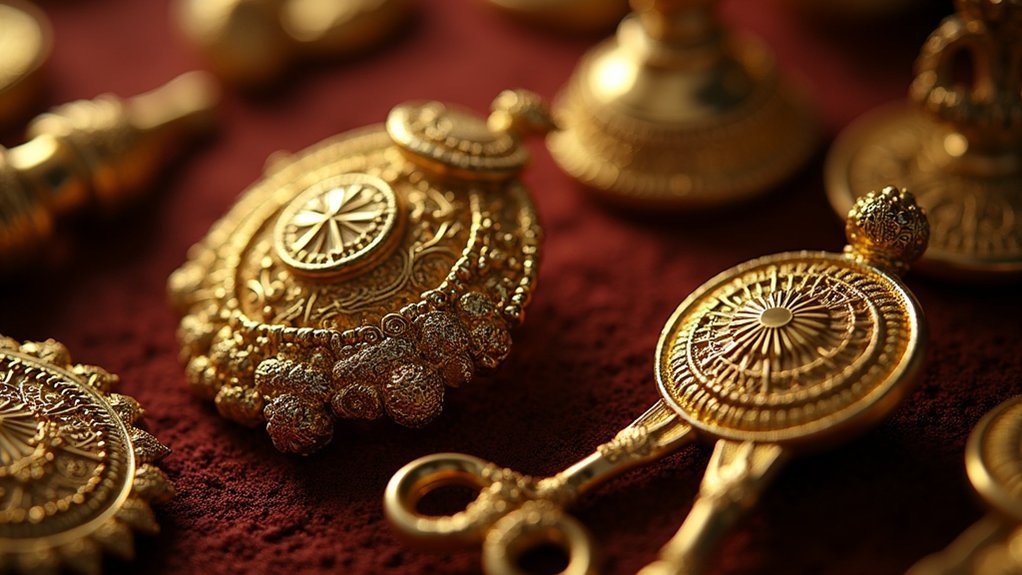

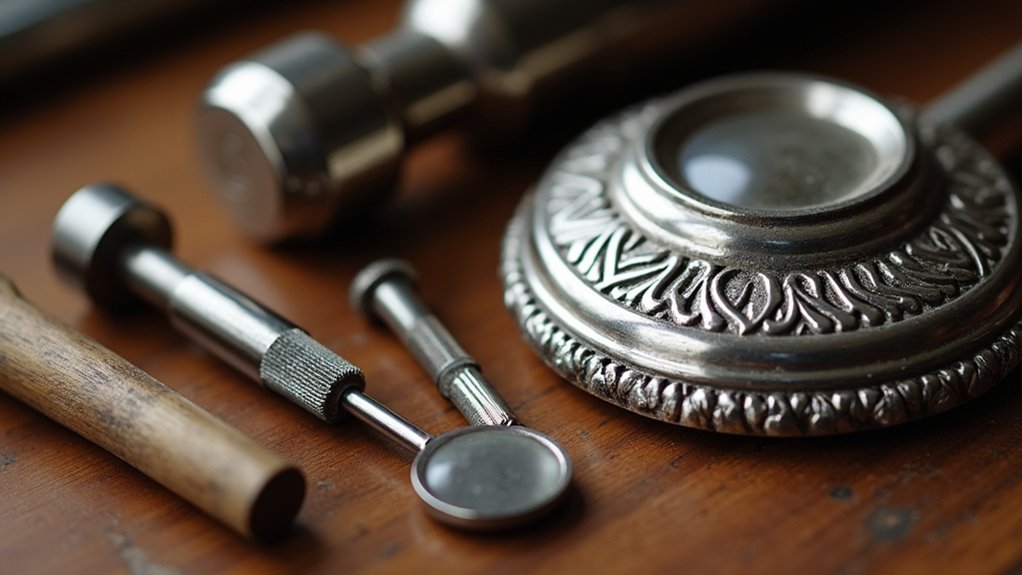
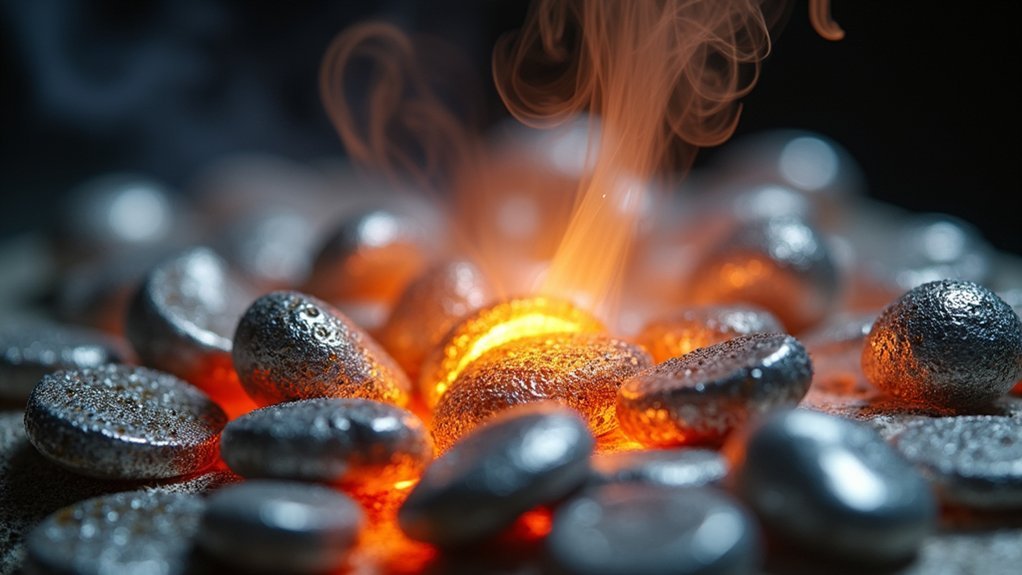
Leave a Reply